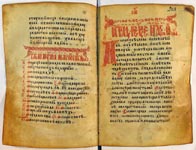Tetraevangelion.
First half (or middle?) of 14th century, with additions from late 13th - early 14th centt. (fols. 20r) and late 15th - early 16th centt. (fols. 19). Serbian version
F (260/270 ı 180/185). fols. 1-18, 21-281; I.
Parchment, paper (fols. 19). Ink, cinnabar, colours.
It is written in a uncial hand.
There are the interlaced head-pieces (fols. 2r, 101v) on folio 2r - with teratological motifs. Large interlaced initials are executed in cinnabar with yellow and green paints and ink (on fols. 2, 76v, 122v, 202). Headings, written in ornamental letters with use of ligatures, form the whole composition with head-pieces and marginal decoration.
The manuscript, mainly, contains the Four Gospels, and folios 19 and 20 are fragments from Aprakos Gospel, in opinion of the authors of the Union Catalogue. It follows from an inscription on the bookplate, contained in the manuscript, that Alexander Hilferding discovered the codex in 1857 in the Patriarchate of Peć, while serving as consul of Russia in Bosnia and Herzegovina. The town of Peć is located on the Bistrica river, 14 km to the north of the Dečani Monastery. On the western outskirts of the town, on the left bank of the river there is the Patriarchate of Peć - a group of churches, which served as the residence of Serbian Archbishops and Patriarches from the 13th century to the beginning of the Turkish occupation of Serbia.
In 1868 the manuscript came into the Imperial Public Library along with the Alexander Hilferding's collection.
Shelfmark: –Õ¡. √ËθÙ. 5





